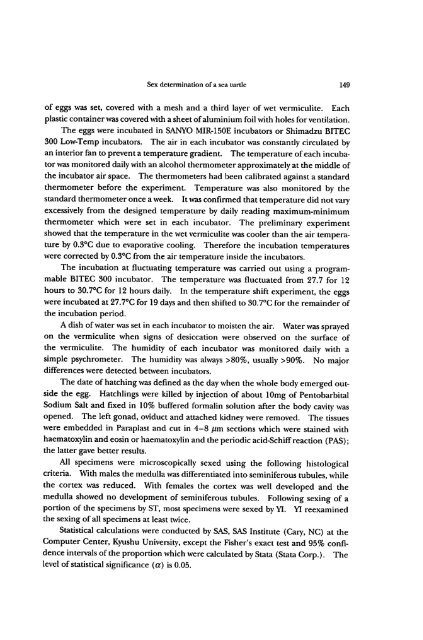Temperature-dependent Sex Determination of a Sea Turde, Caretta ...
Temperature-dependent Sex Determination of a Sea Turde, Caretta ...
Temperature-dependent Sex Determination of a Sea Turde, Caretta ...
Create successful ePaper yourself
Turn your PDF publications into a flip-book with our unique Google optimized e-Paper software.
<strong>Sex</strong> determination <strong>of</strong> a sea turtle 149<br />
<strong>of</strong> eggs was set, covered with a mesh and a third layer <strong>of</strong> wet vermiculite. Each<br />
plastic containerwas covered with a sheet <strong>of</strong>aluminium foil with holes for ventilation.<br />
The eggs were incubated in SANYO MIR-150E incubators or Shimadzu BITEC<br />
300 Low-Temp incubators. The air in each incubator was constandy circulated by<br />
an interior fan to prevent a temperature gradient. The temperature <strong>of</strong> each incuba<br />
tor wasmonitored dailywith an alcohol thermometer approximately at the middle <strong>of</strong><br />
the incubator air space. The thermometers had been calibrated againsta standard<br />
thermometer before the experiment. <strong>Temperature</strong> was also monitored by the<br />
standardthermometeroncea week. It was confirmed that temperaturedid not vary<br />
excessively from the designed temperature by daily reading maximum-minimum<br />
thermometer which were set in each incubator. The preliminary experiment<br />
showed that the temperature in the wetvermiculite was cooler than the air tempera<br />
ture by 0.3°C due to evaporative cooling. Therefore the incubation temperatures<br />
were corrected by 0.3°C from the air temperature inside the incubators.<br />
The incubation at fluctuating temperature was carried out using a program<br />
mable BITEC 300 incubator. The temperature was fluctuated from 27.7 for 12<br />
hours to 30.7°C for 12 hours daily. In the temperature shift experiment, the eggs<br />
were incubated at 27.7°C for 19 days and then shifted to 30.7°C for the remainder <strong>of</strong><br />
the incubation period.<br />
Adish <strong>of</strong>water was setin eachincubator to moisten the air. Water was sprayed<br />
on the vermiculite when signs <strong>of</strong> desiccation were observed on the surface <strong>of</strong><br />
the vermiculite. The humidity <strong>of</strong> each incubator was monitored daily with a<br />
simple psychrometer. The humidity was always >80%, usually >90%. No major<br />
differences were detected between incubators.<br />
The date<strong>of</strong> hatching was defined asthe day when the whole body emerged out<br />
side the egg. Hatchlings were killed by injection <strong>of</strong> about lOmg <strong>of</strong> Pentobarbital<br />
Sodium Salt and fixed in 10% buffered formalin solution after the body cavity was<br />
opened. The left gonad, oviductand attached kidneywere removed. The tissues<br />
were embedded in Paraplast and cut in 4-8 /xm sections which were stained with<br />
haematoxylin and eosinor haematoxylin and the periodicacid-Schiff reaction (PAS);<br />
the latter gave better results.<br />
All specimens were microscopically sexed using the following histological<br />
criteria. Withmalesthe medullawas differentiated into seminiferous tubules,while<br />
the cortex was reduced. With females the cortex was well developed and the<br />
medulla showed no development <strong>of</strong> seminiferous tubules. Following sexing <strong>of</strong> a<br />
portion <strong>of</strong> the specimens byST, mostspecimens were sexed byYI. YI reexamined<br />
the sexing <strong>of</strong>all specimens at least twice.<br />
Statistical calculations were conducted by SAS, SAS Institute (Cary, NC) at the<br />
Computer Center, Kyushu University, except the Fisher's exact test and 95% confi<br />
dence intervals <strong>of</strong>theproportion which were calculated by Stata (Stata Corp.). The<br />
level <strong>of</strong> statistical significance (a) is 0.05.
















